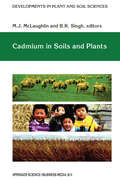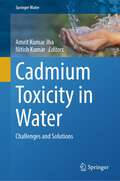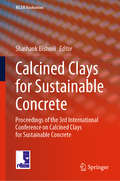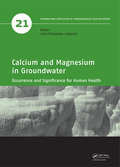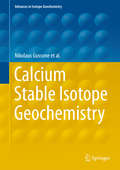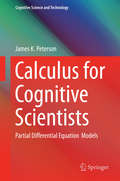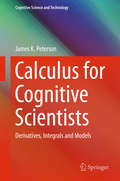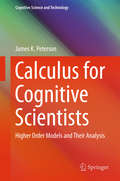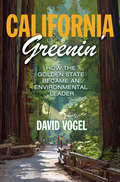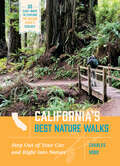- Table View
- List View
Cadmium in Soils and Plants (Developments in Plant and Soil Sciences #85)
by M. J. McLaughlin B. R. SinghOver forty years ago, concern was first focussed on cadmium contamination of soils, fertilisers and the food chain. Adverse effects on human health were first highlighted nearly 30 years ago in Japan with the outbreak of Itai-itai disease. Since then, substantial research data have accumulated for cadmium on chemistry in soils, additions to soils, uptake by plants, adverse effects on the soil biota and transfer through the food chain. However, this information has never been compiled into a single volume. This was the stimulus for the Kevin G. Tiller Memorial Symposium "Cadmium in Soils, Plants and the Food Chain", held at the University of California, Berkeley, in June 1997 as part of the Fourth International Conference on the Biogeochemistry of Trace Elements. This symposium brought together leading scientists in the field of cadmium behaviour in soils and plants, to review the scientific data in the literature and highlight gaps in our current knowledge of the subject. This series of review papers are presented here and deal with the chemistry of cadmium in soils, the potential for transfer through the food chain and management to minimise this problem. We hope this information provides a sound scientific basis to assist development of policies and regulations for controlling cadmium in the soil environment.
Cadmium Toxicity in Water: Challenges and Solutions (Springer Water)
by Amrit Kumar Jha Nitish KumarThis book sheds light on this global environmental issue and proposes solutions to reduce contamination through multi-disciplinary approaches. Water is considered a vital resource because it is necessary for all aspects of human and ecosystem survival. However, due to natural processes and anthropogenic activities, various pollutants have been added to the groundwater system. Among these, heavy metals are some of the most serious pollutants. Cd, a toxic heavy metal used in Ni-Cd batteries, the coloration of plastic and various discarded electronic products released into the water system causes serious health issues. The chronic exposure to Cd produces a wide variety of acute and chronic effects in humans.This edited book brings together a diverse group of researchers to address the challenges posed by global mass poisoning caused by cadmium contamination of water bodies. This book contains three sections. The first section describes the different sources and distribution of cadmium in water ecosystem. The second section explains the health risks linked to cadmium toxicity. The third section addresses sustainable cadmium toxicity mitigation strategies and the potential applications of recent biological technology in providing solutions.
The Calabi–Yau Landscape: From Geometry, to Physics, to Machine Learning (Lecture Notes in Mathematics #2293)
by Yang-Hui HeCan artificial intelligence learn mathematics? The question is at the heart of this original monograph bringing together theoretical physics, modern geometry, and data science. The study of Calabi–Yau manifolds lies at an exciting intersection between physics and mathematics. Recently, there has been much activity in applying machine learning to solve otherwise intractable problems, to conjecture new formulae, or to understand the underlying structure of mathematics. In this book, insights from string and quantum field theory are combined with powerful techniques from complex and algebraic geometry, then translated into algorithms with the ultimate aim of deriving new information about Calabi–Yau manifolds. While the motivation comes from mathematical physics, the techniques are purely mathematical and the theme is that of explicit calculations. The reader is guided through the theory and provided with explicit computer code in standard software such as SageMath, Python and Mathematica to gain hands-on experience in applications of artificial intelligence to geometry. Driven by data and written in an informal style, The Calabi–Yau Landscape makes cutting-edge topics in mathematical physics, geometry and machine learning readily accessible to graduate students and beyond. The overriding ambition is to introduce some modern mathematics to the physicist, some modern physics to the mathematician, and machine learning to both.
Calcined Clays for Sustainable Concrete: Proceedings of the 3rd International Conference on Calcined Clays for Sustainable Concrete (RILEM Bookseries #25)
by Shashank BishnoiThis volume comprises the proceedings of the Third International Conference on Calcined Clays for Sustainable Concrete held in New Delhi, India in October 2019. The papers cover topics related to geology of clay, hydration and performance of blended systems with calcined clays, alkali activated binders, and economic and environmental impacts of the use of calcined clays in cement-based materials. The book presents research on influence of processing on reactivity of calcined clays, influence of clay mineralogy on reactivity, geology of clay deposits, and the environmental impact of use of calcined clays in cement and concrete and field applications of calcined clay in concrete. Apart from giving an overview of the progress of research during the last two years, this work also covers the state-of-the art on the practical aspects of production and use of calcined clays in construction. The contents of this volume will prove useful to researchers and graduate students working in the areas of cement chemistry, cement production, and concrete design.
Calcined Clays for Sustainable Concrete: Proceedings of the 2nd International Conference on Calcined Clays for Sustainable Concrete (RILEM Bookseries #16)
by Fernando Martirena Aurélie Favier Karen ScrivenerThis volume focuses on research and practical issues linked to Calcined Clays for Sustainable Concrete. The main topics are geology of clays, hydration and performance of blended system with calcined clays, alkali activated binders, applications in concrete and mortar, durability of concrete under various aggressive conditions, and economic and environmental impacts of the use of calcined clays in cement based materials.This book compiles the different contributions of the 2nd International Conference on Calcined Clays for Sustainable Concrete, which took place in La Habana, December 5th-7th, 2017.The papers update the latest research in their field, carried out since the last conference in 2015. Overall it gives a broad view of research on calcined clays and their application in the field of construction, which will stimulate further research into calcined clays for sustainable concrete.
Calcium and Magnesium in Groundwater: Occurrence and Significance for Human Health
by Lidia Razowska-JaworekCalcium and magnesium are abundant in groundwater, but the role of groundwater as the essential source of these important nutrients is very often neglected. Hydrogeochemical studies have focused mainly on the distribution and behaviour of constituents that cause deterioration of water quality, such as: nitrate, nitrite or iron and manganese. Theref
Calcium Stable Isotope Geochemistry (Advances in Isotope Geochemistry)
by Nikolaus Gussone Anne-Désirée Schmitt Alexander Heuser Frank Wombacher Martin Dietzel Edward Tipper Martin SchillerThis book provides an overview of the fundamentals and reference values for Ca stable isotope research, as well as current analytical methodologies including detailed instructions for sample preparation and isotope analysis. As such, it introduces readers to the different fields of application, including low-temperature mineral precipitation and biomineralisation, Earth surface processes and global cycling, high-temperature processes and cosmochemistry, and lastly human studies and biomedical applications. The current state of the art in these major areas is discussed, and open questions and possible future directions are identified. In terms of its depth and coverage, the current work extends and complements the previous reviews of Ca stable isotope geochemistry, addressing the needs of graduate students and advanced researchers who want to familiarize themselves with Ca stable isotope research.
Calcretes (International Association Of Sedimentologists Series #44)
by V. Paul Wright Maurice E. TuckerCalcretes are an important component of many ancient fluvial, lacustrine and shallow-marine carbonate sequences, and they are widely developed in many parts of the world at the present time. Calcretes are useful to the earth scientist involved in reconstructing ancient environments, palaeoclimates and palaeographics, and they may also reveal details of soil biota and chemistry. Over the last two decades the journal Sedimentology has published a number of articles on this subject and a compilation of them is presented here. In addition to the five main sections, this volume also includes an introduction to the subject that offers a review of recent work on calcretes. The collection of papers illustrates the range of calcrete occurrences and the great variety of textures and fabrics. This volume is authored and edited by experts and will serve as more than an introduction to the subject for geologists, soil scientists and geographers. If you are a member of the International Association of Sedimentologists, for purchasing details, please see: http://www.iasnet.org/publications/details.asp?code=RP2
Calculus and Mechanics on Two-Point Homogenous Riemannian Spaces (Lecture Notes in Physics #707)
by Alexey V. ShchepetilovThis is an introduction to classical and quantum mechanics on two-point homogenous Riemannian spaces, empahsizing spaces with constant curvature. Chapters 1-4 provide basic notations for studying two-body dynamics. Chapter 5 deals with the problem of finding explicitly invariant expressions for the two-body quantum Hamiltonian. Chapter 6 addresses one-body problems in a central potential. Chapter 7 investigates the classical counterpart of the quantum system introduced in Chapter 5. Chapter 8 discusses applications in the quantum realm.
Calculus for Cognitive Scientists: Partial Differential Equation Models (Cognitive Science and Technology #0)
by James PetersonThis book shows cognitive scientists in training how mathematics, computer science and science can be usefully and seamlessly intertwined. It is a follow-up to the first two volumes on mathematics for cognitive scientists, and includes the mathematics and computational tools needed to understand how to compute the terms in the Fourier series expansions that solve the cable equation. The latter is derived from first principles by going back to cellular biology and the relevant biophysics. A detailed discussion of ion movement through cellular membranes, and an explanation of how the equations that govern such ion movement leading to the standard transient cable equation are included. There are also solutions for the cable model using separation of variables, as well an explanation of why Fourier series converge and a description of the implementation of MatLab tools to compute the solutions. Finally, the standard Hodgkin - Huxley model is developed for an excitable neuron and is solved using MatLab.
Calculus for Cognitive Scientists: Derivatives, Integrals and Models (Cognitive Science and Technology #0)
by James K. PetersonThis book provides a self-study program on how mathematics, computer science and science can be usefully and seamlessly intertwined. Learning to use ideas from mathematics and computation is essential for understanding approaches to cognitive and biological science. As such the book covers calculus on one variable and two variables and works through a number of interesting first-order ODE models. It clearly uses MatLab in computational exercises where the models cannot be solved by hand, and also helps readers to understand that approximations cause errors – a fact that must always be kept in mind.
Calculus for Cognitive Scientists: Higher Order Models and Their Analysis (Cognitive Science and Technology #0)
by James K. PetersonThis book offers a self-study program on how mathematics, computer science and science can be profitably and seamlessly intertwined. This book focuses on two variable ODE models, both linear and nonlinear, and highlights theoretical and computational tools using MATLAB to explain their solutions. It also shows how to solve cable models using separation of variables and the Fourier Series.
Calculus of Variations I (Grundlehren der mathematischen Wissenschaften #310)
by Mariano Giaquinta Stefan HildebrandtThis two-volume treatise is a standard reference in the field. It pays special attention to the historical aspects and the origins partly in applied problems—such as those of geometric optics—of parts of the theory. It contains an introduction to each chapter, section, and subsection and an overview of the relevant literature in the footnotes and bibliography. It also includes an index of the examples used throughout the book.
Calculus of Variations II (Grundlehren der mathematischen Wissenschaften #311)
by Mariano Giaquinta Stefan HildebrandtThis book by two of the foremost researchers and writers in the field is the first part of a treatise that covers the subject in breadth and depth, paying special attention to the historical origins of the theory. Both individually and collectively these volumes have already become standard references.
Calculus Revisited (Mathematics and Its Applications #554)
by R.W. CarrollIn this book the details of many calculations are provided for access to work in quantum groups, algebraic differential calculus, noncommutative geometry, fuzzy physics, discrete geometry, gauge theory, quantum integrable systems, braiding, finite topological spaces, some aspects of geometry and quantum mechanics and gravity.
Calculus with Vectors (Springer Undergraduate Texts in Mathematics and Technology)
by Jay S. TreimanCalculus with Vectors grew out of a strong need for a beginning calculus textbook for undergraduates who intend to pursue careers in STEM fields. The approach introduces vector-valued functions from the start, emphasizing the connections between one-variable and multi-variable calculus. The text includes early vectors and early transcendentals and includes a rigorous but informal approach to vectors. Examples and focused applications are well presented along with an abundance of motivating exercises.The approaches taken to topics such as the derivation of the derivatives of sine and cosine, the approach to limits and the use of "tables" of integration have been modified from the standards seen in other textbooks in order to maximize the ease with which students may comprehend the material. Additionally, the material presented is intentionally non-specific to any software or hardware platform in order to accommodate the wide variety and rapid evolution of tools used. Technology is referenced in the text and is required for a good number of problems.
Caledonian Structures in Britain: South of the Midland Valley
by J. E. TreagusThis volume deals with those sites selected as part of the Geological Conservation Review (GCR) within the southern British part of the Caledonides, that is, the paratectonic Caledonides - a Caledonian terrane without strong and pervasive deformation and metamorphism, such as occurred further north. This orogenic belt formed by long and complex processes of earth movements between 500 and 380 million years before the present (?late Cambrian to mid-Devonian times), and has been classic ground for geologists for two hundred years. It is perhaps no accident that James Hutton in 1795 chose to illustrate his geostrophic cycle (and unconformity) with three visually explicit examples of the deformation wrought on Lower Palaeozoic rocks by Caledonian events. The former Caledonian mountain chain, which can be seen today in fragmented pieces in Scandinavia, Britain and Ireland, and North America, was ultimately the result of the collision of two continental plates and the closure of a former ocean, Iapetus. Some of these fragments, including those in Scandinavia, southern Britain, and the Republic of Ireland and the Maritime Provinces of Canada, are thought to have lain on the south side of the ocean before collision: the rest of North America, northern Ireland, and Scotland are thought to have lain north of the former Iapetus.
California Greenin': How the Golden State Became an Environmental Leader (Princeton Studies in American Politics: Historical, International, and Comparative Perspectives #157)
by David VogelA political history of environmental policy and regulation in California, from the Gold Rush to the presentOver the course of its 150-year history, California has successfully protected its scenic wilderness areas, restricted coastal oil drilling, regulated automobile emissions, preserved coastal access, improved energy efficiency, and, most recently, addressed global climate change. How has this state, more than any other, enacted so many innovative and stringent environmental regulations over such a long period of time? The first comprehensive look at California's history of environmental leadership, California Greenin' shows why the Golden State has been at the forefront in setting new environmental standards, often leading the rest of the nation.From the establishment of Yosemite, America's first protected wilderness, and the prohibition of dumping gold-mining debris in the nineteenth century to sweeping climate- change legislation in the twenty-first, David Vogel traces California's remarkable environmental policy trajectory. He explains that this pathbreaking role developed because California had more to lose from environmental deterioration and more to gain from preserving its stunning natural geography. As a result, citizens and civic groups effectively mobilized to protect and restore their state's natural beauty and, importantly, were often backed both by business interests and bystrong regulatory authorities. Business support for environmental regulation in California reveals that strict standards are not only compatible with economic growth but can also contribute to it. Vogel also examines areas where California has fallen short, particularly in water management and the state's dependence on automobile transportation. As environmental policy debates continue to grow more heated, California Greenin' demonstrates that the Golden State's impressive record of environmental accomplishments holds lessons not just for the country but for the world.
California Greenin': How the Golden State Became an Environmental Leader (Princeton Studies in American Politics: Historical, International, and Comparative Perspectives #157)
by David VogelA political history of environmental policy and regulation in California, from the Gold Rush to the presentOver the course of its 150-year history, California has successfully protected its scenic wilderness areas, restricted coastal oil drilling, regulated automobile emissions, preserved coastal access, improved energy efficiency, and, most recently, addressed global climate change. How has this state, more than any other, enacted so many innovative and stringent environmental regulations over such a long period of time? The first comprehensive look at California's history of environmental leadership, California Greenin' shows why the Golden State has been at the forefront in setting new environmental standards, often leading the rest of the nation.From the establishment of Yosemite, America's first protected wilderness, and the prohibition of dumping gold-mining debris in the nineteenth century to sweeping climate- change legislation in the twenty-first, David Vogel traces California's remarkable environmental policy trajectory. He explains that this pathbreaking role developed because California had more to lose from environmental deterioration and more to gain from preserving its stunning natural geography. As a result, citizens and civic groups effectively mobilized to protect and restore their state's natural beauty and, importantly, were often backed both by business interests and bystrong regulatory authorities. Business support for environmental regulation in California reveals that strict standards are not only compatible with economic growth but can also contribute to it. Vogel also examines areas where California has fallen short, particularly in water management and the state's dependence on automobile transportation. As environmental policy debates continue to grow more heated, California Greenin' demonstrates that the Golden State's impressive record of environmental accomplishments holds lessons not just for the country but for the world.
California's Amazing Geology
by Donald R. ProtheroCalifornia has some of the most distinctive and unique geology in the United States. It is the only state with all three types of plate boundaries, an extraordinary history of earthquakes and volcanoes, and it has many rocks and minerals found nowhere else. The Golden State includes both the highest and lowest point in the continental US and practically every conceivable geological feature known. This book discusses not only the important geologic features of each region in California, but also the complex geologic four-dimensional puzzle of how California was assembled, beginning over 2 billion years ago. The author provides up-to-date and authoritative review of the geology and geomorphology of each geologic province, as well as recent revelations of tectonic history of California’s past. There are separate chapters on some of California’s distinctive geologic resources, including gold, oil, water, coastlines, and fossils. An introductory section describes basic rock and mineral types and fundamental aspects of plate tectonics, so that students and other readers can make sense of the bizarre, wild, and crazy jigsaw puzzle that is California's geological history.
California's Amazing Geology
by Donald R. ProtheroCalifornia has some of the most distinctive and unique geology in the United States. It is the only state with all three types of plate boundaries, an extraordinary history of earthquakes and volcanoes, and it has many rocks and minerals found nowhere else. The Golden State includes both the highest and lowest point in the continental US and practically every conceivable geological feature known. This book discusses not only the important geologic features of each region in California, but also the complex geologic four-dimensional puzzle of how California was assembled, beginning over 2 billion years ago. The author provides up-to-date and authoritative review of the geology and geomorphology of each geologic province, as well as recent revelations of tectonic history of California’s past. There are separate chapters on some of California’s distinctive geologic resources, including gold, oil, water, coastlines, and fossils. An introductory section describes basic rock and mineral types and fundamental aspects of plate tectonics, so that students and other readers can make sense of the bizarre, wild, and crazy jigsaw puzzle that is California's geological history.
California's Amazing Geology
by Donald R. ProtheroCalifornia has some of the most distinctive and unique geology in the United States. It is the only state with all three types of plate boundaries, an extraordinary history of earthquakes and volcanoes, and many rocks and minerals found nowhere else. The Golden State includes both the highest and lowest points in the continental US and practically every conceivable geological feature known. This book discusses not only the important geologic features of each region in California but also the complex geologic four-dimensional puzzle of how California was assembled, beginning over two billion years ago. The author provides an up-to-date and authoritative review of the geology and geomorphology of each geologic province, as well as recent revelations of the tectonic history of California’s past. There are separate chapters on some of California’s distinctive geologic resources, including gold, oil, water, coastlines, and fossils. An introductory section describes basic rock and mineral types and fundamental aspects of plate tectonics, so that students and other readers can make sense of the bizarre, wild, and crazy jigsaw puzzle that is California's geological history.In this second edition, the book has an entirely new final section, “California’s Environmental Hazards and Challenges,” with new chapters on California’s landslides, air and water pollution, renewable energy, and the future of climate change in California.Key Features Thoroughly updates the market-leading textbook on California's geology Is written by an author with 30 years of teaching geology and leading field trips in California Introduces California's unique geological history Covers fundamentals of geology Characterizes specific geographical regions of California Describes major geological resources of California Summarizes the paleontology of California Reviews the likely impact of climate change on California's environment Related TitlesHollocher, K. A Pictorial Guide to Metamorphic Rocks in the Field (ISBN 978-11380-2630-8)Glavovic, B. et al. Climate Change and the Coast: Building Resilient Communities (ISBN 978-04154-6487-1)
California's Amazing Geology
by Donald R. ProtheroCalifornia has some of the most distinctive and unique geology in the United States. It is the only state with all three types of plate boundaries, an extraordinary history of earthquakes and volcanoes, and many rocks and minerals found nowhere else. The Golden State includes both the highest and lowest points in the continental US and practically every conceivable geological feature known. This book discusses not only the important geologic features of each region in California but also the complex geologic four-dimensional puzzle of how California was assembled, beginning over two billion years ago. The author provides an up-to-date and authoritative review of the geology and geomorphology of each geologic province, as well as recent revelations of the tectonic history of California’s past. There are separate chapters on some of California’s distinctive geologic resources, including gold, oil, water, coastlines, and fossils. An introductory section describes basic rock and mineral types and fundamental aspects of plate tectonics, so that students and other readers can make sense of the bizarre, wild, and crazy jigsaw puzzle that is California's geological history.In this second edition, the book has an entirely new final section, “California’s Environmental Hazards and Challenges,” with new chapters on California’s landslides, air and water pollution, renewable energy, and the future of climate change in California.Key Features Thoroughly updates the market-leading textbook on California's geology Is written by an author with 30 years of teaching geology and leading field trips in California Introduces California's unique geological history Covers fundamentals of geology Characterizes specific geographical regions of California Describes major geological resources of California Summarizes the paleontology of California Reviews the likely impact of climate change on California's environment Related TitlesHollocher, K. A Pictorial Guide to Metamorphic Rocks in the Field (ISBN 978-11380-2630-8)Glavovic, B. et al. Climate Change and the Coast: Building Resilient Communities (ISBN 978-04154-6487-1)
California's Best Nature Walks: 32 Easy Ways to Explore the Golden State's Ecology
by Charles HoodExplore some of California&’s most exquisite landscapes with this accessible hiking guidebook featuring descriptions of the flora, fauna, and ecology hikers will discover along the trail. See the oldest trees in the world—and the tallest. Meet earthquake-loving fish, lively island foxes, and endemic birds. Visit the saltwater homes to sea otters and a desert basin where the water is even saltier. In California&’s Best Nature Walks, Charles Hood reveals the golden state&’s unique ecosystems, guiding you through 32 spectacular natural areas, with advice on deciphering the terrain. All are within easy walking distance of the road. This is an essential companion for road-trippers, outdoor enthusiasts, and day hikers—no cleated boots or trekking poles necessary. Locations include the Arcata Marsh and Wildlife Sanctuary, McConnell Arboretum and Botanical Gardens, Olmsted Point at Yosemite National Park, Fossil Falls, Camp Roberts Rest Area along Highway 101, Scorpion Anchorage at Channel Islands National Park, Vasquez Rocks Natural Area, and more!
